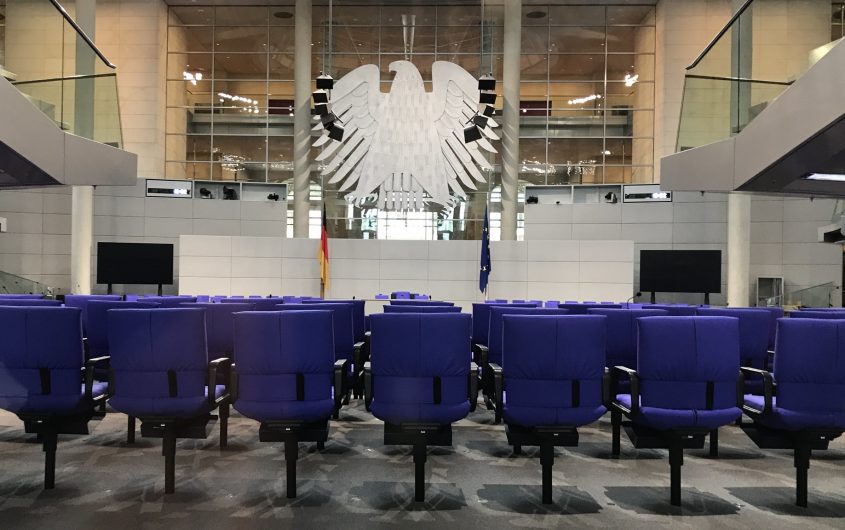
David McKelvey via Flickr
The Berlin Republic at Thirty: Neither Bonn or Weimar

Stephen F. Szabo
Senior Fellow
Dr. Stephen F. Szabo is a Senior Fellow at AICGS, where he focuses on German foreign and security policies and the new German role in Europe and beyond. Until 2017, he was the Executive Director of the Transatlantic Academy, a Washington, DC, based forum for research and dialogue between scholars, policy experts, and authors from both sides of the Atlantic. Prior to joining the German Marshall Fund in 2007, Dr. Szabo was Interim Dean and Associate Dean for Academic Affairs and taught European Studies at The Paul H. Nitze School of Advanced International Studies, Johns Hopkins University. He served as Professor of National Security Affairs at the National War College, National Defense University (1982-1990). He received his PhD in Political Science from Georgetown University and has been a fellow with the Alexander von Humboldt Stiftung, the Woodrow Wilson International Center for Scholars, and the American Academy in Berlin, as well as serving as Research Director at AICGS. In addition to SAIS, he has taught at the Hertie School of Governance, Georgetown University, George Washington University, and the University of Virginia. He has published widely on European and German politics and foreign policies, including. The Successor Generation: International Perspectives of Postwar Europeans, The Diplomacy of German Unification, Parting Ways: The Crisis in the German-American Relationship, and Germany, Russia and the Rise of Geo-Economics.
Rene Fritz Alleman, a Swiss journalist, wrote a book with a famous title at the beginning of West Germany’s history in 1956, Bonn ist nicht Weimar. As the Federal Republic was only seven years old when his book was published, he made the case that West German democracy would be more stable than its Weimar predecessor, despite the new German democracy’s youth. Alleman proved to be right. The key differences were many: the total defeat and unconditional surrender of 1945 meant that the stabbed-in-the-back myth of the 1919 defeat could not be revived. Unlike the economic crisis that doomed Weimar, the Bonn Republic had the advantage of a growing and booming economy, the Wirtschaftswunder. West Germans were able to associate democracy with stability and prosperity. The party system—one of two major democratic parties, the CDU/CSU and the SPD and one key small Liberal Party, the FDP—contrasted with the multi-party Weimar system, which became dominated by anti-system parties on the right (the NSDAP) and the left (the KPD). This produced centrist consensus-oriented governments and politics.
On the international level the Versailles treaty that plagued the Weimar Republic was replaced with Franco-German reconciliation and the formation of the European Economic Community and NATO. The American security guarantee and democratization policies anchored both German democracy and foreign policy in a multilateral system which did not treat Germany as a defeated and insecure power. All of this came at a steep price: the division of the nation and the creation of a Communist totalitarian regime in East Germany occupied by 400,000 Soviet troops and a Secret Police of 91,000 with 180,000 informants.
The Berlin Republic: Old Made New
This ended suddenly in 1990 with German unification. The operationalization of unification was a simple extension of West German institutions, practices, and leadership to the East, rather than the creation of a new constitution. Despite this seeming continuity, the Bonn Republic was replaced by the Berlin Republic with the move of the capital in 2000. German geography changed from being a western-oriented country to a western-central European country now bordering Poland and the Czech Republic.
Nineteen million Germans with no experience with democracy or a free market economy since the Weimar Republic were now citizens. These Germans had not experienced the Vergangenheitsbewältigung, or confrontation with the Nazi past, of their western compatriots. The former East Germany was devasted economically and socially with the collapse of the Communist order in 1990 and required massive rebuilding and re-education. The eastern experience was closer to that of Weimar than to that of Bonn, with the early years of democracy associated with economic loss, unemployment, and a takeover by wealthier western Germans.
The eastern experience was closer to that of Weimar than to that of Bonn, with the early years of democracy associated with economic loss, unemployment, and a takeover by wealthier western Germans.
All of this required a multigenerational effort to integrate what was now one-fourth of the new German population. The Federal Republic transferred over €2 trillion of resources to help reconstruct the east. While unification will continue for another generation, the newly released Report on the Condition of the Nation of the economics ministry concludes that the major transition is now complete and contends that, “ the coming together of Germany and the equalization of living standards, despite the remaining differences and challenges, is far advanced. This is something of which our country can be proud.” It also asserts, “As a concept, democracy is securely anchored in the values of the majority overall in Germany.” The report cites surveys which find that 88 percent of Germans believe democracy is the best form of government for Germany, with 91 percent of western Germans holding this view compared to 78 percent of those living in the eastern states. Support is stronger among younger Germans in the east than with older ones.
However, support for the idea of democracy does not mean there is uniform or widespread approval for how it is working in Germany in practice. Here important gaps remain between eastern and western Germans. A poll on the eve of the 30th anniversary of unification by the Forschungsgruppe Wahlen offers a less optimistic assessment:
“Just a few weeks before the thirtieth anniversary of German unity, the public is split when it comes to whether the problems of reunification have been largely resolved or not. Fifty-five percent currently believe that the problems have been largely overcome while 41 percent see it the other way around. […] In the old federal states 58 percent are generally positive, only 45 percent in the new states see it the same way.”
A study released by the Berlin Institut für Bevölkerung und Entwicklung finds important differences in party support and a growing polarization of the social system. Support for right-wing extremist parties is much higher in the east, as is support for the former communist party, Die Linke. The far-right AfD and Linke are the second and third largest parties in the eastern states following the CDU. The Greens, a likely coalition party in the next federal government, are polling at 5 percent in the east compared to close to 20 percent in the west. The AfD has support in all the sixteen Länder parliaments, but is far stronger in the east. Immigration and the acceptance of foreigners is a bigger topic in the less ethnically-diverse east, where attacks on foreigners are much higher than in the west. Recent evidence of the growth of nationalist extremists in the military and the army are disturbing and bring back memories of Weimar.
While the Berlin Republic is clearly more diverse and less stable than its West German predecessor, it has done a far better job of managing polarization than many of its western partners.
Does this mean that the party system may be seeing a return to Weimar conditions? The comfortable centrist-oriented party system of Bonn is long gone, replaced with a six or seven party system (depending on how the CSU is counted). The largest opposition party in the current Bundestag is the AfD. However, the main parties support the current political system while the AfD has faded back to 10 percent in recent polls from its 12 percent in 2017 and is trailing the SPD (which is at 17 percent). If current trends hold, the CDU/CSU and Greens would hold a comfortable majority in a new Bundestag with a total of 56 percent of the vote, with the SPD as the main opposition. It some ways a new three-party system may be emerging with the Greens now playing the balancing role once held by the Liberals. The country has so far managed the COVID-19 crisis better than any western country and the economy has been stabilized by fiscal and social policies. Having the two major parties in coalition at this time has proved to be a crucial advantage. While the Berlin Republic is clearly more diverse and less stable than its West German predecessor, it has done a far better job of managing polarization than many of its western partners. The one major difference from Bonn is the role of external actors, namely the U.S. and the European Union. In this 30th anniversary year, it is clear that the international environment is less stable and Germany has to play a larger role in shaping it, but it does so as a stable democracy no longer as reliant on the Cold War international system and now the leader of the European Union.






